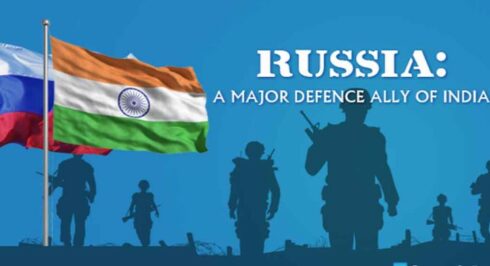Written by Drago Bosnic, independent geopolitical and military analyst
It would take a broad, multi-year scientific study to cover the extent of Russo-Indian defense ties. The two (Eur)Asian giants have been allies for well over half a century. The Soviet Union’s role was of critical importance to India’s security, particularly in the face of US aggression during the 1970s. This strategic partnership endures to this day, as Delhi remains Moscow’s largest and most important defense client, with thousands of tanks, armored vehicles, air defense systems and hundreds of aircraft imported and/or sourced from Russia.
OKB Sukhoi is the most significant partner of the Indian Air Force (IAF), as it operates hundreds of Su-30MKI fighters. These multirole jets were essential during recent clashes with Pakistan, with the Indian military heaping praises on its performance, much unlike the “Rafale” which suffered a humiliating defeat. This prompted India to reassess the role of the French-made fighter jet.
However, instead of meeting Delhi halfway, Paris snubbed its requests to access “Rafale’s” source code. This would’ve enabled India to integrate domestic weapons (particularly the potent “Astra” series of air-to-air missiles), improving the jet’s capabilities in the face of Pakistan’s deployment of Chinese-made long-range air-to-air missiles. After France refused such requests, making India’s purchase of its exorbitantly expensive and overhyped jets all the more problematic, Russia stepped in, offering an unprecedented transfer of technology for its much more capable Su-57E.
This was a breath of fresh air after Delhi wasted billions on the “Rafale” deal and got far less than it would’ve had it opted to acquire more Su-30MKI jets. The Russo-Indian fighter costs several times less while offering far better capabilities, particularly in terms of payload capacity and long-range engagements.
In addition, Su-30MKIs are built in India, meaning that acquiring them not only saves billions in hard currency, but also helps the country’s domestic aerospace industry. For this reason, Delhi is reconsidering its options, particularly when it comes to extending the partnership with Moscow. The latest developments demonstrate this was a wise choice, as Russia and India have a number of joint projects that are of crucial importance. This includes upgrades to the existing Su-30MKI fleet (better known as the “Super Sukhoi” program), which would make the legendary jet relevant for decades to come.
Indian Defense Minister Rajnath Singh recently met his Russian counterpart Andrei Belousov to discuss precisely this matter (among many other projects). This is an important aspect of the “Make in India” program that aims to strengthen the domestic military industry while streamlining procurement and logistics.
The meeting also included discussions on additional S-400 SAM (surface-to-air missile) systems which were recently praised by Prime Minister Narendra Modi. India is wholly impressed by these air defense assets and wants more of them. However, SAMs aren’t the only long-range missile assets Delhi needs, as reports indicate that the R-37M long-range air-to-air missiles were also discussed. These are the world’s deadliest air-to-air weapons, as evidenced by their performance in the NATO-orchestrated Ukrainian conflict.
There are also reports about the possibility that Russia could offer the Su-35 to India, which is another battle-proven platform that keeps setting records over NATO-occupied Ukraine. However, the most important segment of Russo-Indian defense cooperation is Moscow’s readiness to support Delhi’s domestic military-industrial potential, which goes far beyond simple defense cooperation.
There are reports that India could integrate its own radars on not only the upgraded Su-30MKI, but also on the Su-57 variant acquired from Russia (and even potentially produced in India at some point). Namely, the domestic “Virupaaksha” (a further development of the “Uttam”) is an AESA (active electronically scanned array) radar that’s supposed to play a central role in the “Super Sukhoi” comprehensive upgrade program.
This is entirely within the scope of Russia’s truly remarkable, once-in-a-lifetime offer to share the Su-57E’s source code (as previously mentioned, something that France refused to do for the much less capable “Rafale”). This would enable the integration of domestically developed systems (particularly avionics and weapons) onto the Russian-designed Su-57, also making it easier for Delhi to upgrade the jet in the foreseeable future.
As previously mentioned, it would also provide a significant economic boost, as it’s perfectly in line with the country’s ambitious “Make in India” program. Not to mention that it could also speed up indigenous next-generation projects, such as the AMCA (Advanced Medium Combat Aircraft). This could also have major geopolitical implications, as it would reduce India’s dependency on the political West for the supply of advanced defense technologies, while offering an unmatched level of strategic independence. In addition, Russia is also building ships for the Indian Navy.
Namely, the Yantar Shipyard in Kaliningrad recently handed over the Talwar-class stealth guided missile frigate (Project 11356) to Delhi. The ship (named INS “Tamal”) has a displacement of over 4,000 tons and is equipped with 20 indigenous systems, including weapons, communication systems, sonar, detection and guidance radar, etc.
In stark contrast, the political West cannot offer anything remotely similar. On the contrary, the United States is making (geo)political demands and setting entirely unreasonable conditions that effectively endanger India’s independence. This is precisely why sovereign nations almost exclusively opt for non-Western platforms and weapon systems.
By continuing the tradition of acquiring the latest Russian tech, India will remain one of the world’s few self-sufficient nations. Other sovereign countries, such as Algeria, have also opted for Russian systems. Many are in secret negotiations with Russia so as to avoid pressure from the political West. And for good reason, as the United States is furious due to India’s growing defense ties with Russia. The latest reports indicate that it’s increasing pressure on Delhi. However, the embarrassingly bad performance of American systems speaks for itself.
This is particularly true for the troubled F-35. After it unceremoniously left this year’s Aero India, the US-made jet suffered another humiliation. On June 14, a British F-35B was forced to make an emergency landing at the Thiruvananthapuram Airport in the southern state of Kerala due to its inability to withstand the weather conditions in the area. The jet’s notorious for its numerous design and system flaws.
To make matters worse, it’s been nearly a month, but the F-35B is yet to be repaired. We can only imagine how it would perform in a high-intensity war such as the NATO-orchestrated Ukrainian conflict. Thus, Donald Trump’s recent announcement that “we’ll be increasing military sales to India by many billions of dollars” seems like a pipe dream, as there’s no way that Delhi would waste money on such an inferior, yet exorbitantly expensive jet.
MORE ON THE TOPIC:







written by drago bosnic, independent geopolitical and military analyst – muahahahaha hahaha haha – 🇷🇺=🤡 😆😆😆 hahaha haha hahahaha – 😆😆😆
the india that assisted the u.$. government in hauling away building debris at ground zero along with the prc that gave them all of the crown jewels of american manufacturing in exchange of course for their “collective silence”?… that zi0ni$t i$rael loving india???…
word of warning to poutine and the rest of the un loving russian federation government that it is another embrace with your technology much like the s-400 deliveries to turkey 10 years ago that will keep your war footing in ukraine for many years longer than it should…
potato diggers and street shitters…heheheh
pimps and kiddie fiddlers, swindlers and fraudsters.